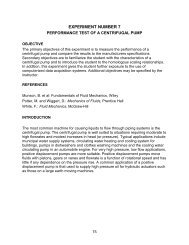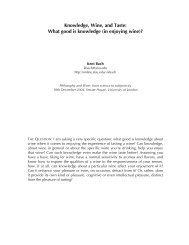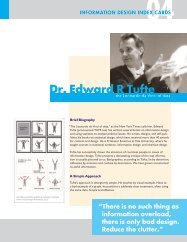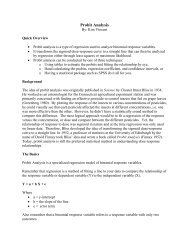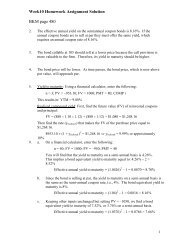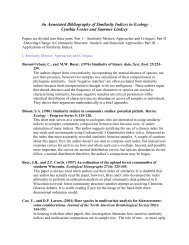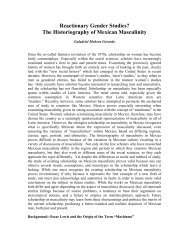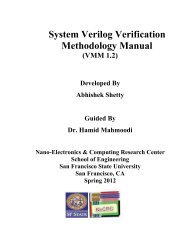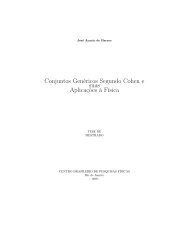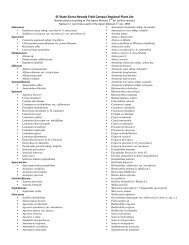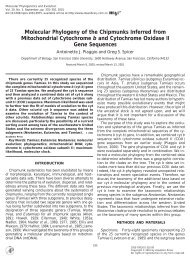Animal Body Plans - Sfsu
Animal Body Plans - Sfsu
Animal Body Plans - Sfsu
Create successful ePaper yourself
Turn your PDF publications into a flip-book with our unique Google optimized e-Paper software.
<strong>Animal</strong> <strong>Body</strong> <strong>Plans</strong><br />
• Aggregate<br />
• Blind sac<br />
• Tube-within-a-tube<br />
• Segmented<br />
• Molluscan<br />
• Arthropod<br />
• Sponges<br />
• Cnidaria, Ctenophora, Platyhelminthes<br />
• Acoelomate -Eucoelomate<br />
• Annelid<br />
• Mollusca<br />
• Arthropoda
•Size<br />
Constraints Imposed by<br />
<strong>Animal</strong> <strong>Body</strong> <strong>Plans</strong><br />
• Exchange of substances with the<br />
environment (diffusion, separation of<br />
alimentary and excretory pores)<br />
• Movement/Locomotion<br />
• Feeding and Foraging<br />
• Habitat/Environment
Physical laws constrain animal form<br />
• Physical requirements constrain what natural<br />
selection can “invent,” including the size of<br />
single cells.<br />
– This prevents an amoeba the size of a pro<br />
wrestler engulfing your legs when wading into a<br />
murky lake.<br />
– An amoeba the size of a human could never<br />
move materials across its membrane fast<br />
enough to satisfy such a large blob of cytoplasm.<br />
– In this example, a physical law - the math of<br />
surface-to-volume relations - limits the evolution<br />
of an organism’s form.
<strong>Body</strong> size and shape affect<br />
interactions with the environment<br />
• An animal’s size and shape have a direct<br />
effect on how the animal exchanges energy<br />
and materials with its surroundings.<br />
– As a requirement for maintaining the fluid<br />
integrity of the plasma membrane of its cells, an<br />
animal’s body must be arranged so that all of its<br />
living cells are bathed in an aqueous medium.<br />
– Exchange with the environment occurs as<br />
dissolved substances diffuse and are transported<br />
across the plasma membranes between the cells<br />
and their aqueous surroundings.
• For example, a single-celled protist living in<br />
water has a sufficient surface area of<br />
plasma membrane to service its entire<br />
volume because it is so small.<br />
– A large cell has less surface area<br />
relative to its volume than a<br />
smaller cell of the same shape.<br />
– These considerations place a<br />
physical constraint on cell size.
Aggregate <strong>Body</strong> <strong>Plans</strong><br />
• Porifera (Sponges) (9000 species mostly marine, 100<br />
species in fresh water)
Sponges are sessile with porous bodies<br />
• The germ layers of sponges are loose federations<br />
of cells, which are not really tissues because the<br />
cells are relatively unspecialized.<br />
• Sponges are sessile animals that lack nerves or<br />
muscles. Individual cells sense and react to<br />
changes in the environment.<br />
• The body of a simple sponge resembles a sac<br />
perforated with holes.<br />
– Water is drawn through the pores into a central cavity,<br />
the spongocoel, and flows out through a larger opening,<br />
the osculum.
• Nearly all sponges are suspension feeders,<br />
collecting food particles from water passing<br />
through food-trapping equipment.<br />
– Flagellated choanocytes, or collar cells, line the<br />
spongocoel (internal water chambers) create a<br />
flow of water through the sponge with their<br />
flagella, and trap food with their collars.
• The body of a sponge consists of two cell<br />
layers separated by a gelatinous region,<br />
the mesohyl.<br />
• Wandering though the mesohyl are<br />
amoebocytes.<br />
– They take up food from water and from<br />
choanocytes, digest it, and carry nutrients to<br />
other cells.<br />
– They also secrete tough skeletal fibers within<br />
the mesohyl.<br />
• In some groups of sponges, these fibers are sharp<br />
spicules of calcium carbonate or silica.<br />
• Other sponges produce more flexible fibers from a<br />
collagen protein called spongin.<br />
– We use these pliant, honeycombed skeletons as bath<br />
sponges.
Sponges
Constraints Imposed by Aggregate<br />
• Sessile (immobile)<br />
<strong>Body</strong> Plan<br />
• Size limitation (I cm to 2 m for Sponges)<br />
• No separation of consumption and<br />
excretion<br />
• Little opportunity for specialization of<br />
functions<br />
• Restricted to Aquatic/Marine Environment
Blind Sac <strong>Body</strong> <strong>Plans</strong><br />
• Cnidaria (anenomes, jellyfish, corals, hydroids)<br />
• Ctenophora (Comb jellies)<br />
• Platyhelminthes (Flatworms)
• Multicellular animals are composed of<br />
microscopic cells, each with its own plasma<br />
membrane that acts as a loading and<br />
unloading platform for a modest volume of<br />
cytoplasm<br />
– This only works if all the cells of the animal have<br />
access to a suitable aqueous environment.<br />
– For example, a hydra, built on<br />
the blind sac plan, has a body<br />
wall only two cell layers thick.<br />
– Because its gastrovascular<br />
cavity opens to the exterior,<br />
both outer and inner layers<br />
of cells are bathed in water.
Phylum Cnidaria: radial symmetry and a<br />
gastrovascular cavity<br />
• The cnidarians (hydras, jellies, sea<br />
anemones, and coral animals) have a<br />
relatively simple body construction.<br />
• They are a diverse group with over 10,000<br />
living species, most of which are marine.<br />
• The basic cnidarian body plan is a sac with a<br />
central digestive compartment, the<br />
gastrovascular cavity.
• This basic body plan has two variations: the<br />
sessile polyp and the floating medusa.<br />
• The cylindrical polyps, such as hydras and sea<br />
anemones, adhere to the substratum by the aboral<br />
end and extend their tentacles, waiting for prey.<br />
• Medusas (also called<br />
jellies) are flattened,<br />
mouth-down versions<br />
of polyps that move by<br />
drifting passively and<br />
by contacting their<br />
bell-shaped bodies.
• Muscles and nerves exist in their simplest forms in<br />
cnidarians.<br />
• Cells of the epidermis and gastrodermis have<br />
bundles of microfilaments arranged into contractile<br />
fibers.<br />
– True muscle tissue appears first in triploblastic animals.<br />
– When the animal closes its mouth, the gastrovascular<br />
cavity acts as a hydrostatic skeleton against which the<br />
contractile cells can work.<br />
• Movements are controlled by a noncentralized<br />
nerve net associated with simple sensory receptors<br />
that are distributed radially around the body.
• The three cnidarian classes show<br />
variations on the same body theme of polyp<br />
and medusa.
Corals, Anenomes, Hydroids and<br />
Jelly Fish - Phylum Cnidaria
Phylum Ctenophora: Comb jellies<br />
possess rows of ciliary plates<br />
• Comb jellies, or ctenophores, superficially<br />
resemble cnidarian medusas.<br />
– However, the relationship between phyla is<br />
uncertain.<br />
• All of the approximately 100 species are<br />
marine.<br />
• Some species are spherical or ovoid, others<br />
are elongate and ribbonlike.
• Ctenophora means “comb-bearer” and<br />
these animals are named for their eight<br />
rows of comblike plates composed of fused<br />
cilia.<br />
• Most comb jellies have a pair of long<br />
retractable tentacles.<br />
– These tentacles are<br />
armed with adhesive<br />
structures (colloblasts)<br />
that secrete a sticky<br />
thread to capture<br />
their food.
Comb Jellies – Phylum Ctenophora
• Another way to maximize exposure to the<br />
surrounding medium is to have a flat body.<br />
– For instance, a tapeworm may be several<br />
meters long, but because it is very thin, most of<br />
its cells are bathed in the intestinal fluid of the<br />
worm’s vertebrate host, from which it obtains<br />
nutrients.<br />
• While two-layered sacs and flat shapes are<br />
designs that put a large surface area in<br />
contact with the environment, these<br />
solutions do not lead to much complexity in<br />
internal organization.
• Planarians and other flatworms lack organs<br />
specialized for gas exchange and circulation.<br />
– Their flat shape places all cells close to the<br />
surrounding water and fine branching of the<br />
digestive system distributes food throughout the<br />
animal.<br />
– Nitrogenous wastes<br />
are removed by<br />
diffusion and simple<br />
ciliated flame cells<br />
help maintain<br />
osmotic balance.
• Planarians move using cilia on the ventral<br />
epidermis, gliding along a film of mucus<br />
they secrete.<br />
– Some turbellarians use muscles for undulatory<br />
swimming.
Flatworms<br />
(Phylum Platyhelminthes)<br />
Pseudoceros bimarginatus<br />
Thysanozoon sp
Constraints Imposed by Blind Sac<br />
•Size<br />
• Limited locomotion<br />
<strong>Body</strong> <strong>Plans</strong><br />
• No Separation of Consumption and<br />
Excretion<br />
• Restricted to Aquatic or Marine<br />
environment, or as an internal parasite of<br />
terrestrial animals
Tube within a tube <strong>Body</strong> <strong>Plans</strong><br />
• Acoelomate<br />
• Pseudocoelomate<br />
• Coelomate
Advantages of Tube within a Tube<br />
<strong>Body</strong> <strong>Plans</strong><br />
• Separation of feeding and excretory pores<br />
• Specialization of tissues for different<br />
functions<br />
• Development of true muscle tissue<br />
permitting greater movement
Segmented <strong>Body</strong> <strong>Plans</strong><br />
• Annelida<br />
• Arthropoda
• The coelom of<br />
the earthworm,<br />
a typical annelid,<br />
is partitioned by<br />
septa, but the<br />
digestive tract,<br />
longitudinal blood<br />
vessels, and<br />
nerve<br />
cords penetrate<br />
the septa and<br />
run the animal’s<br />
length.
Evolution of the Exoskeleton<br />
• Calcareous or chitinous plates that provide<br />
protection and rigid structure against<br />
muscles can do work<br />
• Mollusca – Calcium carbonate<br />
• Arthropoda - Chitin
Molluscan <strong>Body</strong> Plan
Arthropod <strong>Body</strong> Plan
• The diversity and success of arthropods is<br />
largely due to three features: body segmentation,<br />
a hard exoskeleton, and jointed appendages.<br />
• Groups of segments and their appendages have become<br />
specialized for<br />
a variety of<br />
functions,<br />
permitting<br />
efficient<br />
division of<br />
labor among<br />
regions.
Echinoderm <strong>Body</strong> Plan<br />
• Radially Symetrical (pentameric)<br />
• Endoskeleton (calcium carbonate)<br />
• Slow moving, bottom dwelling
Phylum – Echinodermata (starfish, urchins, sea<br />
cucumbers, crinoids, sand dollars, sea biscuits, etc.)



